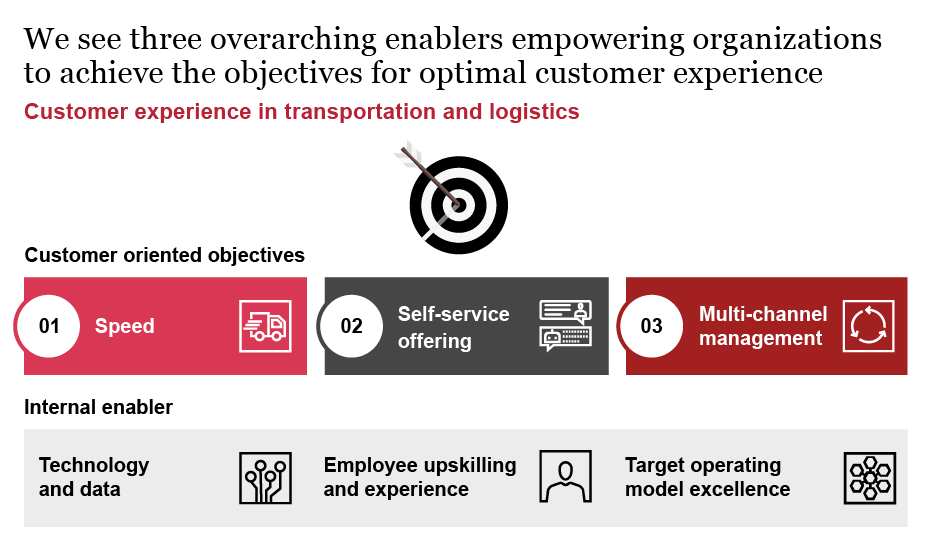In the wake of record profits in 2022, the transport and logistics sector now faces challenges from lower prices and surplus capacity. But regardless of the impact of changing market conditions on their business, logistics companies always must provide the fundamental "seven Rs" to customers: the right product(s) must reach the right recipient at the right level of quality, at the right time, in the right quantity, with the right information, and at the right price.
Fueled by B2C experiences, B2B expectations around usability and responsiveness have risen, thus an additional eighth "R" has joined the B2B list: the right experience. While price remains a top priority for transport and logistics customers, providing a seamless customer experience based on accurate data is crucial to secure future success and certainly is a competitive advantage.
Companies excelling in customer experience management usually have higher customer loyalty, positive recommendations, increased market share, and higher profitability. To measure their "Return on eXperience" (RoX), the financial return a company receives because of providing an exceptional customer experience, companies need to have a clear understanding of their customer journey. They must make effective use of data and technologies to support superior experiences, equip employees with timely and accurate information across channels, and implement automation, virtual assistants or chatbots, and self-service options.
In this article, we outline the status of customer experience in the transport and logistics industry, their customer objectives, and enablers, as well as how transport and logistics companies can transform towards a cutting-edge customer experience.
Growing expectations
Leading transport and logistics companies are prioritizing customer experience. The major players state that improving performance in this area will lead to higher growth rates, and successful companies in the industry are actively hiring customer experience managers.
However, PwC research into customer experience1 across industries shows customer experience in the overall transport and travel sector is less mature than in those such as telecommunications, retail and consumer, and financial services:
In many industries, companies with a high level of customer experience maturity see significant impact on their bottom line. Based on our project experience across industries, they reduce their costs by up to 25% compared to companies with a low level of customer experience maturity, because of lower customer acquisition and retention costs. They also make greater use of self-service options, and a have a higher first contact resolution (FCR) rate when customers report issues and claims.
Moreover, the best-performing companies across industries with regards to customer experience can enhance their top line and grow their revenue by 5 to 10% after improving their customer experience to a high maturity level because of higher numbers of returning customers and the ability to charge higher premiums.
While there is room for improvement within the transport and logistics sector, companies in this industry can distinguish themselves from competitors by enhancing their customer experience.
For transport and logistics companies, we believe offering a great customer experience creates a virtuous circle.
1 Based on Customer Service satisfaction

Positive experiences can lead to higher customer satisfaction ratings, meaning existing customers could increase their share of wallet with the company and new customers are attracted. By generating additional new business, transport and logistics companies can access a larger customer base and gather more data from the ecosystem, which can be utilized to tailor and refine their offerings and achieve operational excellence.
These improvements result in lower costs and lower prices, which combined with good service, then leads to an even better customer experience. As a result, improving their customer experience can have a meaningful impact on both the top and bottom line.
The right experience
How does a leading customer experience look like? For transport and logistics companies, it starts with potential customers reaching out to them, receiving quotes, followed by a seamless customer onboarding process. Once they are operationally working together, it means more timely and efficient responses to enquiries, best-in-class operational execution, real-time problem solving, fast complaints and claims management, and efficient billing processes.
To achieve this, there are three customer-oriented objectives and three internal enablers that companies in the transport and logistics sector should focus on:

Customer-oriented objectives
The first objective is speed – customers expect companies to be easily accessible, especially for urgent problems such as shipment status or complaints and claims management, and that problems are solved quickly, ideally after the first contact.
Objective two, self-service, is also increasingly important especially in the B2B parcel and express delivery sector – according to conversations with our clients, transport and logistics customers used self-service options significantly more often during the pandemic than they had before and are now comfortable with them.
Thirdly, a multi-channel communication significantly impacts the quality of the customer journey. Customers often want to be able to switch seamlessly between digital and analogue contact options and choose their preferred channel.
Three internal enablers
The customer objectives are enabled primarily by three elements: technology and data, employee upskilling and experience, and target operating model excellence.
Technology and data can allow companies to address the transformational forces they face and be ready to offer the level of service customers expect. The key aspects are for example:
- Automation of routine tasks such as creating standard quotes and orders, back-office processes using intelligent process automation (IPA) and updating shipments using data on, for example, weather patterns or shipping delays.
- Customer identification using a range of tools including voice recognition, customer sentiment identification and automatic call distributors (ACDs) to direct callers to the right agent in a service department. Customer identification tools can also be used for personalization and sales targeting. Agents can identify the customer and have a 360° customer view, with a full and transparent record of customer data.
- Self-service technologies that allow real-time interaction on customer engagement platforms and apps - end-to-end. For instance, customers can have the most accurate up-to-date information about the shipments, highly efficient invoicing, and billing processes as well as immediate incident and claims management.
- Tracking including GPS tracking to provide real-time information, and integration of shipment data gathered by sensors. Some transport and logistics companies already use their own sensors during the status tracking process to offer customers even more precise insights.
- Big data usage and continuous data exchange are needed to fuel the tools and technology described and connect with many more customers at an individual level. This requires a standardized access point for all data, as well as platforms that include relevant data from third parties such as ship owners and insurance companies.
- Generative artificial intelligence, machine learning-based predictions and forecasting to provide proactive customer service support, options, and information such as predictive pricing. Flexible and proactive intervention in the supply chain is possible if incidents occur during the delivery process. For example, this allows customers to choose the next best action (or even automated decision making) in a changing situation, creating opportunities for a dynamic supply chain and options for dynamic pricing.
Within daily operations, employee upskilling and the employee experience need to be of the highest quality to provide the best customer experience. Employees need access to the right tools and information to keep customers up to date and provide the service they expect. High-quality training also improves job satisfaction and reduces staff turnover.
Finally, transport and logistics companies should develop a strategically aligned, fit-for-growth operating model matching the overall target of a data-driven, tech-enabled, and people-led company which determines the organization, processes, governance, KPIs, technological tools and culture.
With the objectives of speed, self-service and multi-channel experience in mind, and the right enablers in place, the exhibit below shows what a seamless, exemplary customer experience could look like:

How to become a CX leader
To achieve the eight Rs described above, emphasizing exceptional customer experience, a consistent pursuit of RoX is key.
Transport and logistics companies should follow six steps to embark on their customer experience transformation:
- 1Know and understand your customer: Gain deep insights into your customers and their specific service needs, encompassing factors such as volume and complexity of requests based on a clear customer-centric data and tech strategy.
- 2Define your target picture and operating model: Develop a clear vision of your future customer journey, considering both aspirations and cost constraints and derive the target operating model.
- 3Develop a transformation roadmap: Create a strategic roadmap that aligns with your customer experience priorities outlined in the target picture.
- 4Empower and engage employees Enhance employees’ skills and satisfaction levels to boost customer satisfaction. Deploy staff according to their strengths and preferences, granting appropriate authority.
- 5Enhance automation: Implement automation to enable self-service options for customers and improve efficiency in directing them to the appropriate service channels, all while directing personalized attention where it is needed.
- 6Implement efficient technology solutions: Provide the necessary tools and solutions for enhanced customer self-service and streamlined customer processes, aligned with your tech strategy. This includes a comprehensive 360° view and simplification of IT tools and user interfaces for both employees and customers.
We strongly believe that transport and logistics companies have to prioritize customer experience management to become more cost effective, increase revenue, have better insights, and proactively convert their insights into opportunities. All this will build a competitive edge in the future.
Kai Müller, Julia Bülow, and Dominik Liedtke also contributed to this article.
Contact us



